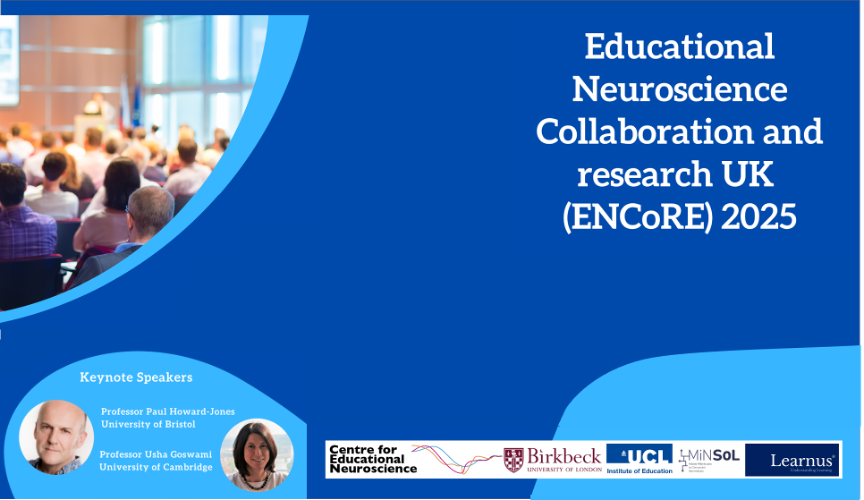
The inaugural ENCoRE conference, hosted by the Centre for Educational Neuroscience, took place in London, UK, in April 2025.
The published Proceedings, containing abstracts of the research presented at the conference, are available here: Encore-2025-Proceedings.
The keynote speakers were Professor Usha Goswami (University of Cambridge), who gave a talk entitled ‘Dyslexia, rhythm, language and the developing brain’; and Professor Paul Howard-Jones (University of Bristol), who gave a talk entitled ‘The journey from neuroscience research to education’. The keynotes can be viewed below (thank you to our sponsors, Learnus, for the filming and production of these videos).
CEN member Mahi Elgamal, gives an overview of the conference:
Highlights from the Educational Neuroscience Collaboration and Research 2025 Conference
The Educational Neuroscience Collaboration and Research UK (ENCoRe UK) successfully held its inaugural conference on the 24th and 25th of April 2025 at Birkbeck, University of London. This two-day event brought together leading experts, researchers, practitioners, and early career researchers from institutions including UCL Institute of Education, University of Cambridge, Birkbeck, and several international partners (e.g., Chile, USA, Turkey, Canada). The conference aimed to foster collaboration, advance innovation, and critically explore current research trends, methodologies, and developments in the field of educational neuroscience.
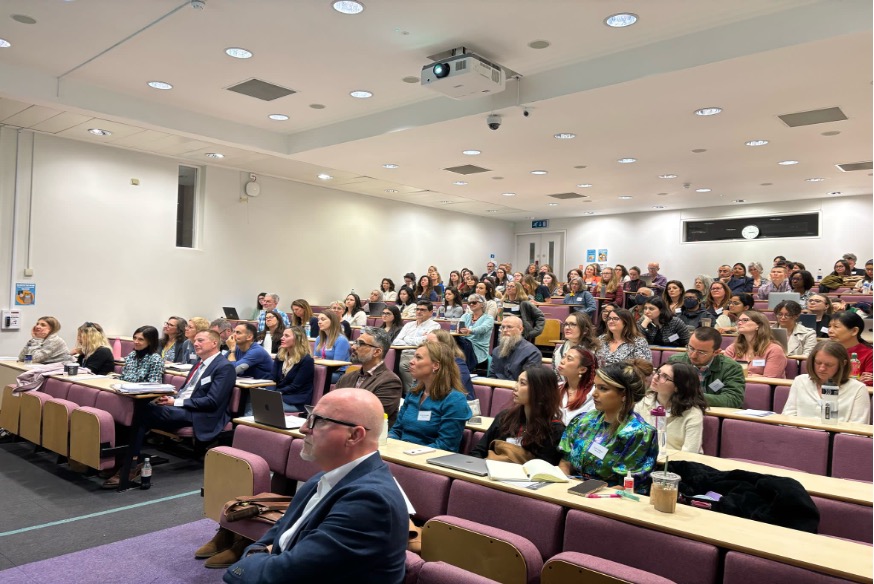
Pre-conference: Exploring neuroimaging techniques in educational neuroscience
The conference opened with a pre-conference workshop tailored to PhD students and early-career researchers, offering a grounded introduction to three major neuroimaging methods used in educational neuroscience: functional Magnetic Resonance Imaging (fMRI), functional Near-Infrared Spectroscopy (fNIRS), and Electroencephalography (EEG). Rather than staying at the theoretical level, the session addressed how these methods function in real-world educational research—what types of data they generate, how they’re best applied, and where they encounter practical or conceptual limitations in school settings. Lucy Palmer, Dr. Magdalena Kachlicka, Imogen Green, and Dr. Gemma Goldenberg each gave brief talks on different methodological approaches.
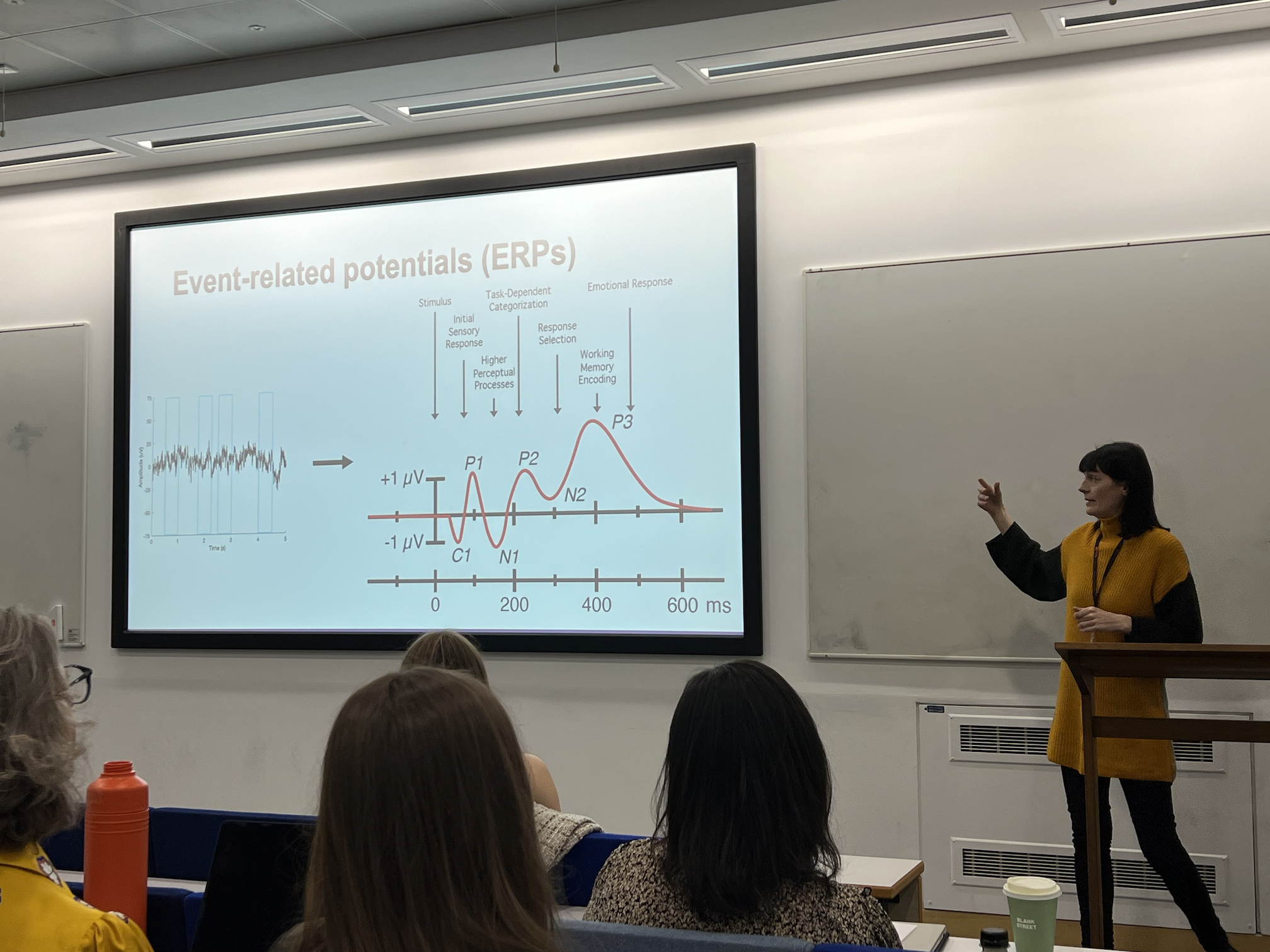
Slide from Dr. Kachlick’s presentation explaining the link between ERP waveforms and cognitive processes
A central part of the session involved group work, where attendees were asked to apply these methods to real research questions. Small teams debated which tool would suit their own studies, and more importantly, why. They examined the logistical and conceptual limitations—What does this method actually measure? Can it be used with young children? Is it realistic in a school setting?—and whether neuroimaging would genuinely add insight or simply complicate things.
The exercise helped demystify these technologies. It also exposed a common theme: neuroimaging is not automatically the right tool just because it’s available or cutting-edge. Deciding to use it requires clarity about what you want to know, and an honest look at whether the method can answer that question in an educationally meaningful way.
Connecting research to the classroom
Professor Usha Goswami (University of Cambridge) opened the conference with a keynote on rhythm processing differences in the dyslexic brain, offering a clear example of how neuroscience can inform targeted, evidence-based educational interventions aimed at improving outcomes for dyslexic learners.
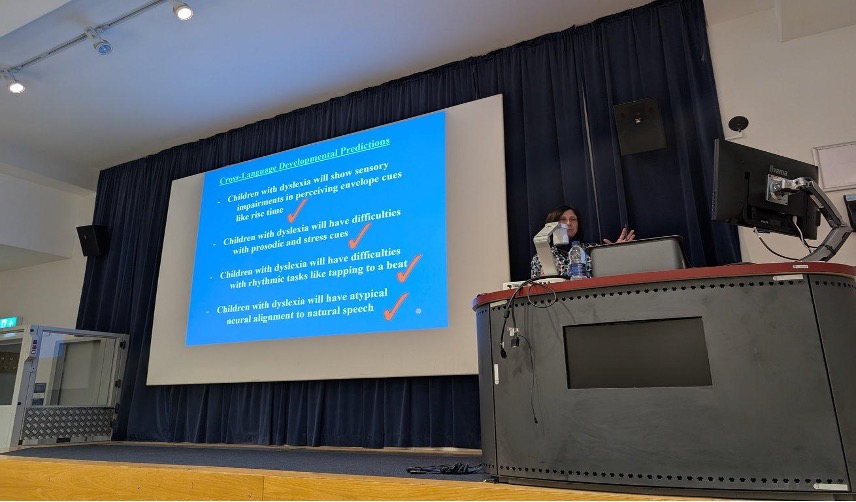 Slide from Prof. Usha Goswami on cross-linguistic developmental predictors in dyslexic children
Slide from Prof. Usha Goswami on cross-linguistic developmental predictors in dyslexic children
On Day Two, Professor Paul Howard-Jones (University of Bristol) highlighted the fundamental role of teachers in shaping how neuroscience-informed strategies are implemented—or whether they succeed at all. He argued that more sustained engagement between researchers and practitioners is essential if educational neuroscience is to have practical impact.
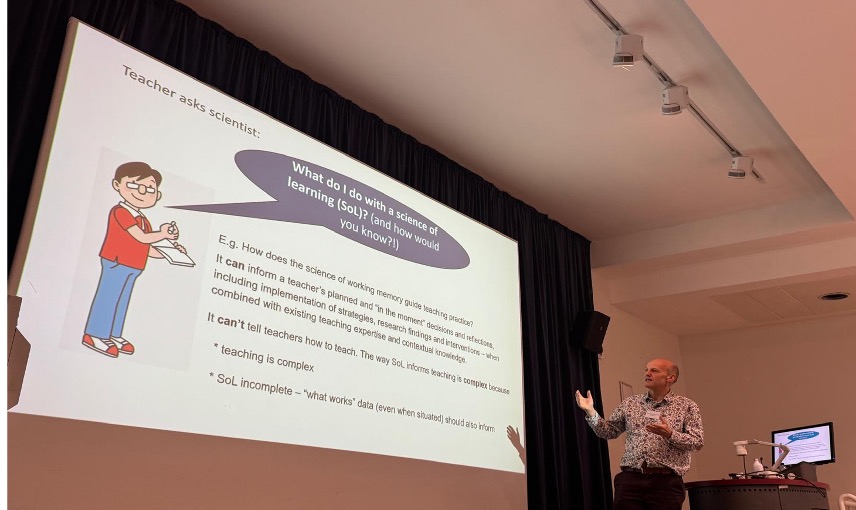 Slide from Prof. Paul Howard-Jones on how science of learning can guide teaching practice
Slide from Prof. Paul Howard-Jones on how science of learning can guide teaching practice
Expanding the evidence base
Throughout the conference, presentations illustrated the extensive range and methodological diversity within educational neuroscience. Topics included early cognitive predictors of learning difficulties, multilingualism’s effects on academic achievement, cognitive benefits associated with outdoor learning, executive functions, and novel interventions using technology such as adaptive VR.
Lightning talks provided concise overviews of current research projects, featuring work from researchers affiliated with institutions including Oxford, Cambridge, University of Tübingen, University of Talca, and University College Dublin. These sessions encompassed a variety of themes, such as rhythm-based language interventions, cognitive correlates of sports activities, emotional influences on numerical cognition, and cross-domain relationships in mathematical achievement.
Tracking and supporting learning in context
The second day began with research addressing how to measure and support cognitive skills in real-world educational settings. Studies included EEG-based assessments of cognitive load, VR-driven learning tools, and approaches to strengthening executive function in the classroom. Together, these sessions addressed a key challenge in the field: designing tools that are both scientifically robust and usable in everyday educational practice.
Facing methodological and global challenges
Speakers addressed ongoing methodological challenges inherent in conducting robust educational neuroscience research, particularly within school-based settings. Issues raised included the practicalities of data collection, ethical considerations, and ensuring interventions align effectively with classroom realities. Additionally, the necessity of a global perspective in educational neuroscience research was underscored, highlighting diverse international approaches and their implications for translating findings across different national contexts.
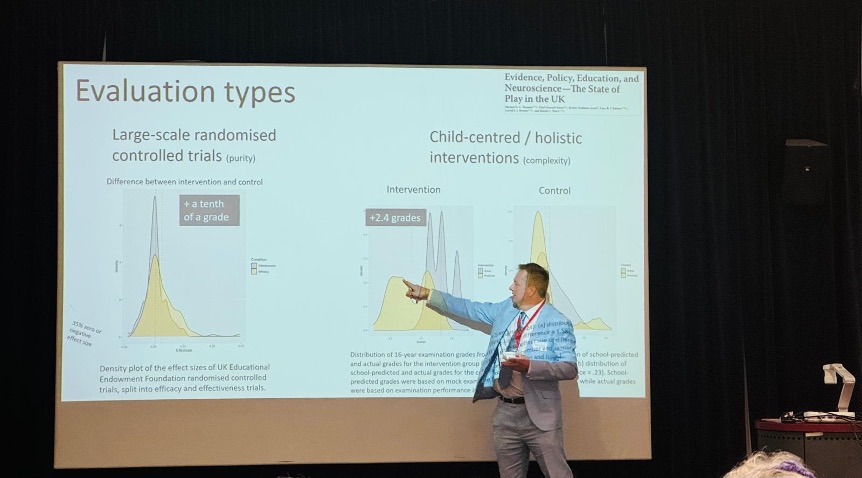 Slide from Prof. Michael Thomas’s closing remarks on types of evaluation
Slide from Prof. Michael Thomas’s closing remarks on types of evaluation
Open questions: What’s next for educational neuroscience?
The conference closed with an interactive forward-looking debate, structured around three key challenges for the field:
- Evaluation and impact: How can multiple evaluation methods be integrated effectively to determine which educational interventions are most successful—identifying specifically whom they benefit, under what circumstances, and when implemented by whom?
- Global perspectives and national contexts: Given varying international educational priorities, how can educational neuroscience research maintain broad relevance while also responding to individual national needs?
- Longitudinal approaches: Recognising that learning evolves over time, how can developmental, long-term research be delivered sustainably and without prohibitive cost?
Discussions about how to move the field forward culminated on the second and last day of the conference, emphasising the ongoing complexity of translating neuroscience research into educational practice, highlighting both challenges and potential pathways forward.
The conference concluded with reflections on the necessity of collaboration between educators and neuroscience researchers. These questions remain open, but they reflect a clear consensus: advancing educational neuroscience requires sustained dialogue, thoughtful integration of findings, and careful consideration of real-world educational contexts.
